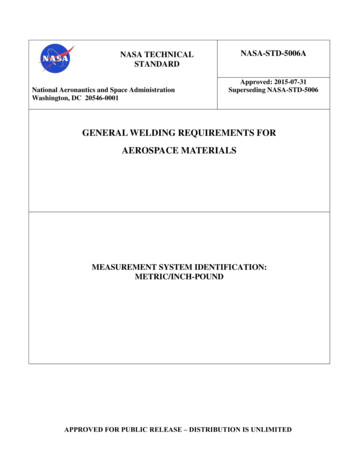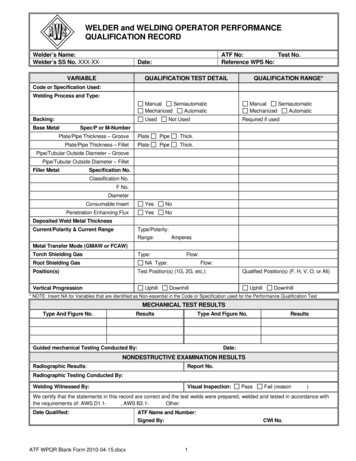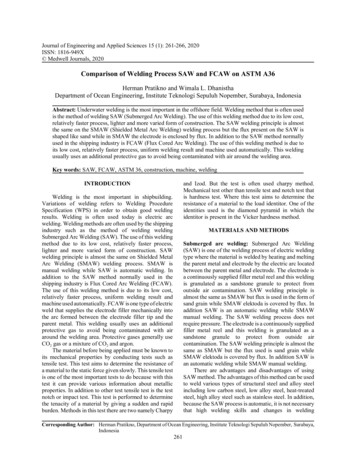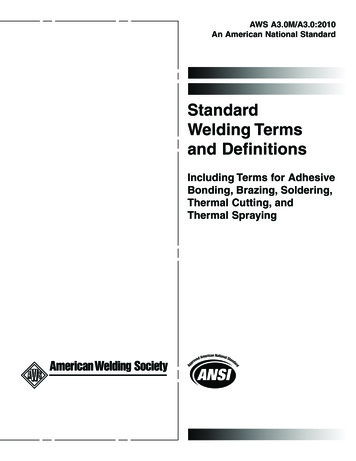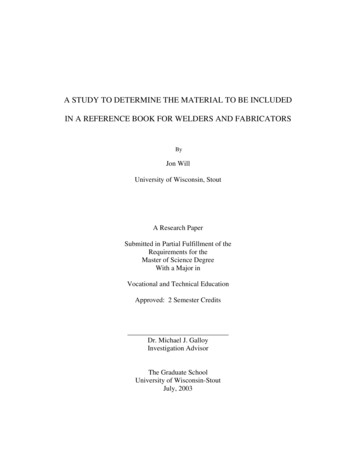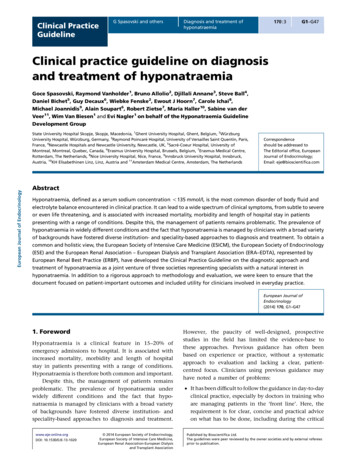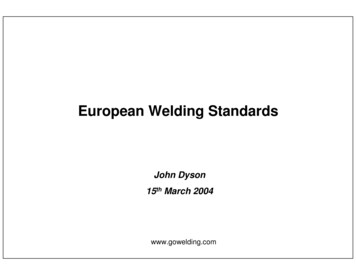
Transcription
European Welding StandardsJohn Dyson15th March 2004www.gowelding.com
European StandardsHarmonised StandardsNot all EN Standards are Harmonised, only those that are considered to satisfy relevantESRs in product directives. Harmonised standards contain an appendix Z, whichdefines which directives and ESRs the standard meets. For example:- EN ISO 15614 willbe harmonised, but other routes for weld procedure approval may not be, such as ENISO 15610, EN ISO 15611, EN ISO 15612 etc.ISO StandardsThere is a Gentleman’s agreement that attempts to make all EN standards into ISOstandards and vice versa, but this does not work for all standards.www.gowelding.com
Application StandardsEN 13445 : Pressure Vessels ( BS 5500)EN 12952 : Water Tube Boilers ( BS 1113)EN 12953 : Shell Boilers ( BS 2790)EN 13480 : Piping ( BS 806, Not BS 2640, BS 2971)www.gowelding.com
Specifications & Approval of Welding ProceduresSummary of EN ISO Specificationswww.gowelding.com
Specifications & Approval of Welding ProceduresIntroduction to The Specification & Approval of Welding ProceduresEN 288 Part 1 Will Become EN ISO 15607Material Grouping for both Procedures and Welder ApprovalCR ISO 15608 this standard has no current EN equivalentContents of a WPSEN 288 Part 2 Will Become EN ISO 15609 (Part 1 Arc, Part 2 for Gas welding)Welding Procedure TestEN 288 Part 3 will become EN ISO 15614 Part 1 (Steel and Nickel Alloys)EN 288 Part 4 will become EN ISO 15614 Part 2 (aluminium and its alloys)Other routes for procedure approval, such as previous experience, approvedconsumables etc. Are unlikely to become harmonised for use with the PEDwww.gowelding.com
Specifications & Approval of Welding ProceduresMechanical TestingEN ISO 15614-1 adopts the same mechanical test as EN288-3, except that the bend testminimum former angle has been increased from 120q to 180q and fillet welds require aminimum of 4 macros. When impact testing is required the minimum thickness hasbeen reduced from 12mm to 6mm.HARDNESS TESTINGEN ISO 15614-1 Makes no distinction between multi-pass and single pass welds. Themaximum values for material in group 1 and 2, is the same as that stated in EN288-3 forsingle run welds ( non-heat treated 380Hv10 max, heat treated 320Hv10max)All groups now have maximum hardness specified, except : Group 6, Cr-Mo-V steels, non- heat –treated conditionHardness Survey is not required for :Steels in Sub-group 1.1 (yield strength of 275N/mm2 or less)Stainless Steels in Group 8Nickel Alloys in Groups 41 to 48www.gowelding.com
Specifications & Approval of Welding ProceduresMATERIAL GROUPING CR ISO 15608Material GroupEN ISO 15614-1EN288-31Re 460N/mm2Re 360N/mm22TMCP 360N/mm2TMCP 360N/mm23Q T and PHd steelsQ T and PHd steels41.5Ni,0.7Cr,0.7Mo,0.1V max0.75Cr,0.6Mo,0.3V max50.35C,10Cr,1.2Mo max10Cr, 1.2Mo max612.5Cr,1.2Mo,0.35V max12.2Cr, 1.2Mo, 0.5V max70.35C,30Cr10 Ni max8Austenitic10.5 Cr 309Ni 10 (Cryogenic Steels)Austenitic10DuplexDuplex110.25 C 0.50.25 C 0.541 to 48Ni based alloys (Identical To ASME )www.gowelding.com
Specifications & Approval of Welding ProceduresMATERIAL GROUPINGCR ISO 15608Main Groups are sub-divided into sub groups Based on yield strength for carbon steel in groups 1, 2 and 3. However these subgroups are not considered for material grouping in EN ISO 15614-1, the grouping isbased on same specified yield strength or less in the main group(the same as EN288-3). Based on Alloy content for materials in all the other groups. EN ISO 15614-1, mayapprove the steels in the same sub-group or all the lower sub groups in the maingroup, depending on the suffix in EN ISO 15614-1 table 3:- (b) or (c)sub-group 8.1 Chrome d 19%sub-group 8.2 Chrome 19%sub-group 8.3 Austenitic with 4 Mn d 12A test in one sub group within group 8, approve all other steels in the same sub groupONLY ( therefore a test in 304 approves 316, 347 and 321, but not 309 or 310) For example :- Group 8:-Note :-Impact requirements do not affect the sub grouping approval range as they doin the ASME code.www.gowelding.com
Specifications & Approval of Welding Proceduresa) Covers the equal orlower specified yieldstrength steels of thesame groupb) Covers steels in thesame sub-group and anylower sub-group withinthe same groupc) Covers steels in thesame sub-group.www.gowelding.com
Specifications & Approval of Welding ProceduresGoverning Thickness For Approval RangeThe controlling thickness that determines the approval range in EN288-3 is dependanton the joint type; for example:- the controlling thickness is that of the thicker part, for abranch weld it’s the thickness containing the joint preparation. However in EN ISO15614 both thicknesses in the joint are given independent approval ranges if they differ.The thickness range also applies to the deposit thickness of multiple process welds. Itis reasonable to consider a single run deposit in a multiple process weld to be amultiple run weld in determining its individual approval range.Note the different plate thickness approval range for fillet welds.www.gowelding.com
Specifications & Approval of Welding ProceduresRange of ApprovalButt and branch weld thickness and weld depositTest PieceThickness (t)and alsoDeposit Thicknessfor multipleprocess welds 3mmSingle runMultiple runSingle runMultiple run0.7t- 1.3t0.7t - 2t0.8t - 1.1tt - 2t 3 12mm0.5t (3min) -1.3t3mm - 2t0.8t - 1.1t3mm - 2t 12 100mm0.5t-1.1t0.5t - 2t0.8t - 1.1t0.5t - 2t 100mmNot Applicable50mm - 2t0.8t - 1.1t0.5t - 1.5tEN ISO15614-1Note:- The upper range of approval is 12mm if there is an impactrequirement and impact testing has not been carried outwww.gowelding.comEN 288-3
Specifications & Approval of Welding ProceduresRange of ApprovalFillet weld thickness and Throat Thickness EN ISO15614-1Plate ThicknessTest PieceThickness (t)Throat ThicknessSingle and Multiple RunSingle runMultiple runt 3mm0.7t- 2t0.75 a - 1.5 aNo Restriction3 t 30mm0.5t (3min) - 1.2t0.75 a - 1.5 aNo Restrictiont t 30mmt 5mmThroat thicknesswelded, Noapproval rangeNo RestrictionFillet welds Qualified by butt welds:- The throat thickness approval range is based on the deposit thickness and the platethickness range will have to be modified to that stated above.www.gowelding.com
Specifications & Approval of Welding ProceduresRange of ApprovalOn DiameterEN ISO 15614-1EN 288-3Test PieceApprovalTest PieceApproval 25mm OD0.5D-2DPipe/tube 168.3mm OD0.5-2D 0.5DPipe/tube 168.3mm OD 0.5D and platesPipe 150mm in PA or PCPlatePipe 500mm 25mm ODPlatePipe 500mm All Positionswww.gowelding.com
Specifications & Approval of Welding ProceduresRange of ApprovalWelding PositionThe range of approval in EN ISO 15614-1 is exactly the same as EN 288-3.If there is No impact or hardness survey requirement, one position covers all positions.If Impact tests are required, the weld procedure approves other positions requiring thesame or less heat inputIf a Hardness survey is required, the weld procedure approves other positions requiringthe same or higher heat input.If a test includes both a high and low heat input position, then all intermediate heatinput positions are approved, refer to EN ISO 15614-1 figure 6Note:- EN ISO 15614-1 requires heat input to be measured. When impacts are required the heat input is limited to 25% of test value When Hardness is required the heat input is limited to - 25% of test valuewww.gowelding.com
Specifications & Approval of Welding ProceduresRange of ApprovalJoint TypeThe approval range for joint type in EN ISO 15614-1 and EN 288-3 are essentially thesameFor Example:Butt welds approve fillet weldsSingle sided welds approve backed, double sided and back gouged weldsButt welds approve T-butt weldsButt welds in pipe approve branch connections With angles between 60 - 90 Backed welds approve double sided weldsN.B. a fillet weld approves a fillet weld only BUT if mechanical properties are importantsupplement with a butt weldShielding and backing gassesRange of approval restricted to the EN439 gas symbol Or Restricted to Nominalcomposition Used in test if no EN439 code exists. A weld made without a backing gasalso approves welding with a backing gas.www.gowelding.com
Specifications & Approval of Welding ProceduresRange of ApprovalFiller Metal EN ISO 15614-1Filler Materials Cover Other materials subject to : Equivalent mechanical propertiesSame type of covering, core or fluxSame nominal compositionSame or lower hydrogen contentIf impact there is an impact requirement then the filler metal can not be changed fromthe brand used in the procedure test. This does not apply to solid wires of the samedesignation and nominal composition.The size of the filler metal can be changed providing the heat input requirements, ifrequired, are met.Weld with a filler metal does no approve welds made without filler, or vice versawww.gowelding.com
EN ISO 15614 Part 8 Tube to tube-plate jointswww.gowelding.com
EN ISO 15614 Part 8 Tube to tube-plate jointsRequirements similar to BS4870 Part 3Welder Approvals to : EN ISO 9606 Part 1- 5 / EN1418 (Mechanised)Size Of Test piece :Tube D 40mm10 tubes for Triangular Pitch, 12 for squareTube D 40mm 7 tubes for Triangular Pitch, 9 for squareOne pitch type approves all pitch types with the same or greater ligament dimension(d1)www.gowelding.com
EN ISO 15614 Part 8 Tube to tube-plate jointswww.gowelding.com
EN ISO 15614 Part 8 Tube to tube-plate jointsTesting RequirementsVisual Penetrant Radiography to EN1435 Macro 2 off full width and length of test piece (Along A and B) Hardness survey Push Out Testfor materials in group 2,3,4,5,6,7OptionalThe standard has its own acceptance criterion similar to EN ISOwww.gowelding.com5817
EN ISO 15614 Part 8 Tube to tube-plate jointswww.gowelding.com
EN ISO 9606Welder Approval TestingNote, the proposed revision to ISO 9606 Part 1 has not been agreed.Therefore EN287 Part 1 will continue, and all references in this documentto ISO9606 Part 1 should read the latest version of EN287 Part 1This does not affect the other parts of ISO 9606www.gowelding.com
EN ISO 9606Welder Approval TestingNote:- this standard should not be confused with ISO 9606 which currentlyexists, only the EN version is harmonised. EN 287 Part 1 : 2004 {was to have be replaced by EN ISO 9606 Part 1 butagreement could not be reached}Fusion Welding Of Steel Materials: Published EN ISO 9606 Part 2 {Replaces EN287 Part 2} : Not PublishedFusion Welding Of Aluminium and its Alloys EN ISO 9606 Part 3 :1999 {No EN Equivalent} : PublishedFusion Welding Of Copper and Copper Alloys EN ISO 9606 Part 4 :1999 {No EN Equivalent} : PublishedFusion Welding Of Nickel and Nickel Alloys EN ISO 9606 Part 5 :2000 {No EN Equivalent} : PublishedFusion Welding Titanium and Titanium Alloys, Zirconium and zirconium alloyswww.gowelding.com
EN 287-1:2004 Welder Approval TestingTest pieces for butt, fillet, pipe, fillet to pipe are identical to old EN 287-1Each process in a multi process wed an be used separately with the range of thicknessdictated by the deposit thickness attributed to hat process, t s.Range of Approval for Butt WeldsSame as the old version of EN 287-1Range of Approval For Fillet WeldsPlate thickness, t 3mm, Approves a range t to 3mmPlate thickness, t 3mm, Approves all thicknesses from 3mmsingle layer fillet weld approves single layer onlymulti layer fillet weld approves single and multi layerBranch WeldsQualified by pipe butt welds for branch angles 60 Set on:- Branch diameter and branch thickness considered in approvalSet in :- Main pipe thickness and branch diameter considered in approvalwww.gowelding.com
EN 287-1:2004 Welder Approval TestingDiametersThe approval range for pipe diameters according to EN ISO 9606-1 :Pipe Diameter 25mmD to 2 DPipe Diameter 25mm0.5D (25mm Min) and above PlatesNote:The testing of small bore pipes require a minimum circumference of 150mm, oradditional test pieces must be welded to a maximum of 3.www.gowelding.com
EN 287-1:2004Welder Approval Testing:- Material GroupsEN 287-1:2004(Note:- Check flux type approval range table 3)GroupApproval Range1.1, 1.2, 1.41.1, 1.2, 1.42 1.31, 2, 3, 9.1, 113GradeOldEN 287-1C steel 460 ReWO1TMCP steel 360 ReWO3Q T, PH steels 360 Re51, 2, 3, 9.1, 111, 2, 3, 9.1, 4, 5, 6, 7, 111, 2, 3, 9.1, 4, 5, 6, 7, 11C 0.35 CrMo, noV steel61, 2, 3, 9.1, 4, 5, 6, 7, 11High V CrMo(Ni) steel71, 2, 3, 9.1, 4, 5, 6, 7, 118, 9.2, 9.3, 101, 2, 3, 9.1, 11WO4W119.2, 9.3, 1.1, 1.2, 1.410.5 Cr 30 steelAustenitic steelNi steels 3% maxNi steels 10% max8, 9.2, 9.3, 10Duplex stainless steelW11489.19.2, 9.31011Low V CrMo steels1.1, 1.2, 1.3, 1.4, 11www.gowelding.comC steels 0.25 C 0.5WO2
EN 287-1:2004 Welder Approval TestingRange of Approval for Electrode CoatingThe approval range for EN 287-1:2004, Is similar to the old EN287-1For a single sided root run with no backing, no change of flux type is permitted. The followingapproval range is permitted for the fill and capping runs: Basic approves basic (B), rutile (R), acid (A) and combinations Cellulosic (C) approves cellulosic only Rutile approves R, RR, RA, RB, RCEN 287-1:2004 also differentiates between solid and cored wiresA Solid wire approves metal cored and vice versa, but not Flux cored wires.Basic FCAW approves all FCAW wiresRutile approves rutile and basic wires onlyGeneral:- The filler material must be compatible with the parent material used for the test weldwww.gowelding.com
EN 287-1:2004 Welder Approval TestingRange of Approval on PositionEN 287-1: 2004 Has a similar positional approval range to the old EN287-1Generally more difficult position approves for easier positionse.g. fixed inclined pipe approves all except V-down (PG)Overhead (PE) approves all except V-down (PG)JL045 Approves all positions except HL045 and PFwww.gowelding.com
EN 287-1:2004 Welder Approval TestingValidity Of ApprovalThe prolongation rules are the
exists, only the EN version is harmonised. EN 287 Part 1 : 2004 {was to have be replaced by EN ISO 9606 Part 1 but agreement could not be reached} : Published Fusion Welding Of Steel Materials EN ISO 9606 Part 2 {Replaces EN287 Part 2} : Not Published Fusion Welding Of Aluminium and its AlloysFile Size: 427KBPage Count: 39


